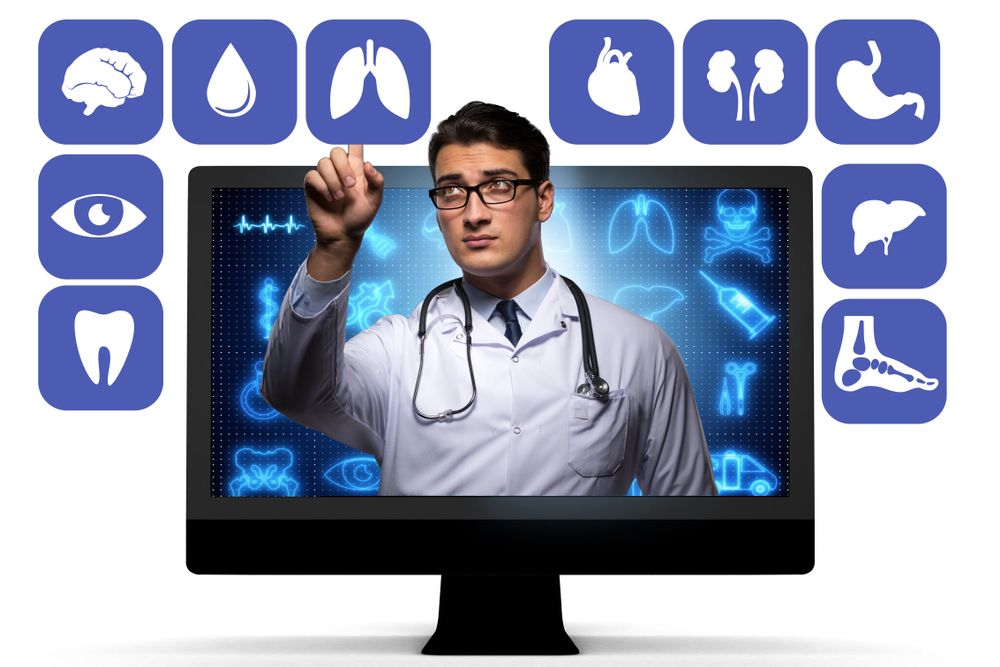Both telemedicine and in-person medical care have much to offer and can provide many different tools and levels of support to patients. Telemedicine won’t fully replace in-person visits.
Telemedicine is a growing field of health care that brings digital technology into diagnostics, support, disease management, preventative measures, education, and follow-up care. With telemedicine, you can use computers, smartphones, and mobile platforms to access health care services from afar. (Learn More)
In-person doctor visits are more personal than a virtual visit and provide a high quality of care. (Learn More)
There are some negatives involved with each type of care. Telemedicine may not be covered by insurance, for example, and in-person doctor visits can be costly and inconvenient. (Learn More)
If you need information, help managing a chronic condition, or a consult from a specialist, telemedicine can often offer a high level of support and more options for improving your health care experience. (Learn More)
Telemedicine and in-person doctor visits can complement each other and help to provide a full continuum of care.
Benefits of Telemedicine
Telemedicine continues to evolve with rapidly improving technology and enhancements in the medical field. Telemedicine, as defined by the World Health Organization (WHO), refers to the use of information and communication technologies (ICTs) to provide health care services virtually.
Services are provided through digital platforms and can cross geographical barriers. You can access telemedicine services from your computer, smartphone, tablet, or any wireless or mobile device from virtually anywhere, at any time. Telemedicine is therefore highly convenient.
It can include:
- Preventative care and education.
- Health care and medical information.
- Access to health care providers from afar.
- Video and real-time virtual appointments.
- Store-and-forward options, which can connect providers to other providers and patients to specialists, allowing for easy information sharing for diagnostic and treatment purposes.
- Management and treatment of chronic conditions.
- Follow-up care.
Pros of In-Person Treatment

Much of the time, people still feel that in-person appointments can offer better quality care. As a result, most people prefer to see doctors face to face for most health care needs.
An in-person doctor visit can feel more personable than a virtual visit. Seeing a doctor in person can allow for conversations you may not have virtually and offer them a chance to physically evaluate you.
Some medical conditions and issues will require in-person care to diagnose, manage, and treat them. Skin cancer, for example, may require a biopsy and an in-person visit to recognize and diagnose.
A relationship with your primary care provider is important. An annual in-person checkup can catch things that might have been overlooked with a virtual appointment.
Cons of Each
Not all insurance providers will cover all aspects of telemedicine, and in some cases, they will not offer reimbursement for services.
Telemedicine can expand access to medical services, but it may also be increasing spending on health care. For instance, the journal U.S. Pharmacist reports that spending on antibiotics for children diagnosed with respiratory issues through telemedicine platforms was higher than those who visited doctors in person.
In-person treatment can often be inconvenient and requires much more time and effort than using telemedicine methods. Specialists often have a long waiting list and may be located far away, requiring extended travel time and long waits in physician offices.
Telemedicine can be much more convenient. You can often access services from the comfort of your home at a time that works for you. You may be able to send information directly to a health care provider and receive a rapid response. If needed, your concern can be easily escalated to another provider or specialist.
When Telemedicine May Be Ideal
Telemedicine continues to grow and expand, offering more services and options to people around the globe. As such, there are many times when telemedicine can offer benefits over in-person medical treatment.
- Convenience: You may not live in an area where it is easy to get to a doctor or specialist. Telemedicine can cross geographic barriers and expand access to medical care in rural and underserved populations.
It can also save time — driving time and time spent waiting in physicians’ offices. You can set virtual appointments when they are convenient to you and in a space that works best. - Cost: Telemedicine is often considered to be more cost-effective than in-person treatment services. Telemedicine can eliminate office visits and unnecessary trips to emergency departments. There are many websites and apps that offer medical information and even symptom checkers and diagnostic tools to provide education and preventative measures.
- Communication: Health care providers can use telemedicine to talk to each other and work together more easily. Your medical records can be stored and accessed digitally, removing the need for cumbersome paper files. All your information can be in one place and easily accessible.
Physicians can more easily collaborate about your care. They also have more access to real-time advancements and continuing education as well. - Quality: Several different studies have shown that for various conditions and ailments, telemedicine can be at least equal to in-person doctor visits in terms of quality of care, diagnosis, treatment, and improvement of health. You can use many different telemedicine platforms to find information on health care and obtain access to medical providers and care digitally.
- Advancements: As technology improves, so do telemedicine options. While in the past, seeing your doctor in person may have been the best option, this may not always be true today. Thanks to advanced imaging, apps, Bluetooth, GPS, video conferencing, streaming abilities, and expanded technology, telemedicine can often offer a high quality of care that is convenient, cost-effective, and more streamlined than traditional health care methods.
Most of the time, telemedicine can be used in conjunction with doctor visits. For instance, you may see your primary care provider first for routine health care needs and then use telemedicine for follow-up visits or a referral to a specialist.
References
Telemedicine Opportunities and Development in Member States. (2010). World Health Organization (WHO).
Consumers Like Telehealth, but Still Prefer Face-to-Face Healthcare. (April 2018). mHealth Intelligence.
4 Ways Telemedicine Is Changing Healthcare. (August 2018). HealthLeaders.
Pediatric Telemedicine Versus In-Person Visits Means More Antibiotic Prescriptions. (April 2019). U.S. Pharmacist.
Telemedicine. Centers for Medicare and Medicaid Services.
A Prospective Comparison of Telemedicine Versus In-Person Delivery of an Interprofessional Education Program for Adults With Inflammatory Arthritis. (March 2016). Journal of Telemedicine and Telecare.
Outcomes of Telemedicine Video-Conferencing Clinic Versus In-Person Clinic Follow-up for Implantable Cardioverter-Defibrillator Recipients. (September 2017). Circulation: Arrhythmia and Electrophysiology.




